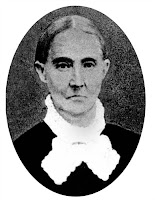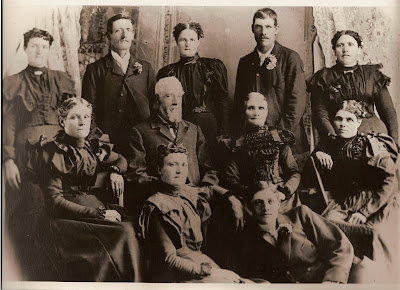On the McKinnon, Wyoming website (the city McKinnon being named after Archibald McKinnon Sr.), there are some memoirs written by the Stake President of the stake that was being formed there. Archibald was the 1st counselor and accompanied the stake pres on many occasions to the city - which is why they named it after him. Anyways, I will post every now and then a memoir written that has Archibald in it, or one that he was present for as he accompanied the author of the memoir.
They can all be found here:
http://www.mckinnonwyoming.com/the_wyoming_woodticks.htm
Below is written by Archibald Pullman - the first bishop in the McKinnon, WY stake.
In preparing this brief history of McKinnon, Wyoming, consideration is given to the origin of the Woodruff Stake of Zion, named after the late president of the Church, Wilford Woodruff. The McKinnon Ward became a vital part in the life history of President John M. Baxter, who was then president of the Woodruff Stake, and of his beloved uncle, President Archibald McKinnon. (McKinnon Ward became as his namesake).
The purpose of our people migrating into the McKinnon area was to homestead lands, in the hope of future security and happiness for their families. These were a hard-working people—good Latter-day Saints. Many were related through marriage. All the group had previous acquaintance with each other. Some had developed very intimate relationships. Others had had dealings with each other in the livestock business. This particular area afforded good land of 160 acres for each family, with grazing rights on the range for their livestock. In addition to this, desert entries could be taken up which would afford land holdings up to nearly 1000 acres for each family. This expansion of property over their previous holdings in Utah and Sanpete Counties greatly increased their potential for future success in the livestock business.
Their first consideration, however, was for their spiritual and social well-being. Through some missionary work and contacts with the stake authorities, a ward organization was effected in the 1918, involving some 300 souls.
I was the first bishop of McKinnon Ward. Many times we held campfire meetings when stake authorities visited us and we lacked conveniences for a large gathering. These were appointed to be held by a rippling stream of spring water which ran nearby and which made a perfect setting to listen to the counsel of this great man, President Baxter. We had a great interest in his exciting experiences in the building up of this far-flung part of his stake. He, in company with other stake officers, would travel from 90 to 100 miles by team and wagon, sleeping at night by the roadside, preparing meals as they traveled, and intermittently watering and feeding their horses as they traveled up steep hills and into passes where roads were hazardous and unprepared. It involved at times 10 to 12 days and 180 miles of travel to complete the circuit of the outlying wards and branches of his stake. This slow mode of travel gave opportunity for observation, not only of the condition of the people, but of the country in general.
One particular experience that President Baxter related was of great interest to our people. It involved a trip that he and his stake family took into our area on the way to Manila, some 15 miles beyond. President Archibald McKinnon was in company with his stake officers at that time. They had observed, during the day, many squatters settled upon various quarter sections of land. They camped that night on the very spot where we held campfire meetings. This particular spot seemed to be a prearranged place, as the spring of cool fresh water running through a grove of trees made a pleasant campsite. That evening comments were made by the group regarding the squatters. This conversation caused a deep contemplation in the mind of Archibald McKinnon. After the evening prayer he made this prophetic utterance. "Brethren, I want to say to you, in the name of the Lord Jesus Christ, that these squatters will never prove up on this land. There will yet come a day when a colony of Latter-day Saints will settle upon these lands, and they will prove up on them and make their homes here, becoming an organization of the Church in this very locality." This prophecy was made about the 1910. It was literally fulfilled. Peculiar as it may seem, President McKinnon died on April 22,1915, at the very time settlement began in this area – almost to the very day – by a colony of Latter-day Saints.
The success of our endeavors in this life cannot be claimed by one individual – nor can it be given to any one other. We ride, as it were, upon the shoulders of mighty men who have gone on before. Therefore, when a life combines not only goodness and virtue but also devotion to duty and patriotism in the spirit of sacrifice, and a deep, abiding faith in God, it becomes our duty to unfold such to our posterity.
by Archibald Pulham
They can all be found here:
http://www.mckinnonwyoming.com/the_wyoming_woodticks.htm
Below is written by Archibald Pullman - the first bishop in the McKinnon, WY stake.
In preparing this brief history of McKinnon, Wyoming, consideration is given to the origin of the Woodruff Stake of Zion, named after the late president of the Church, Wilford Woodruff. The McKinnon Ward became a vital part in the life history of President John M. Baxter, who was then president of the Woodruff Stake, and of his beloved uncle, President Archibald McKinnon. (McKinnon Ward became as his namesake).
The purpose of our people migrating into the McKinnon area was to homestead lands, in the hope of future security and happiness for their families. These were a hard-working people—good Latter-day Saints. Many were related through marriage. All the group had previous acquaintance with each other. Some had developed very intimate relationships. Others had had dealings with each other in the livestock business. This particular area afforded good land of 160 acres for each family, with grazing rights on the range for their livestock. In addition to this, desert entries could be taken up which would afford land holdings up to nearly 1000 acres for each family. This expansion of property over their previous holdings in Utah and Sanpete Counties greatly increased their potential for future success in the livestock business.
Their first consideration, however, was for their spiritual and social well-being. Through some missionary work and contacts with the stake authorities, a ward organization was effected in the 1918, involving some 300 souls.
I was the first bishop of McKinnon Ward. Many times we held campfire meetings when stake authorities visited us and we lacked conveniences for a large gathering. These were appointed to be held by a rippling stream of spring water which ran nearby and which made a perfect setting to listen to the counsel of this great man, President Baxter. We had a great interest in his exciting experiences in the building up of this far-flung part of his stake. He, in company with other stake officers, would travel from 90 to 100 miles by team and wagon, sleeping at night by the roadside, preparing meals as they traveled, and intermittently watering and feeding their horses as they traveled up steep hills and into passes where roads were hazardous and unprepared. It involved at times 10 to 12 days and 180 miles of travel to complete the circuit of the outlying wards and branches of his stake. This slow mode of travel gave opportunity for observation, not only of the condition of the people, but of the country in general.
One particular experience that President Baxter related was of great interest to our people. It involved a trip that he and his stake family took into our area on the way to Manila, some 15 miles beyond. President Archibald McKinnon was in company with his stake officers at that time. They had observed, during the day, many squatters settled upon various quarter sections of land. They camped that night on the very spot where we held campfire meetings. This particular spot seemed to be a prearranged place, as the spring of cool fresh water running through a grove of trees made a pleasant campsite. That evening comments were made by the group regarding the squatters. This conversation caused a deep contemplation in the mind of Archibald McKinnon. After the evening prayer he made this prophetic utterance. "Brethren, I want to say to you, in the name of the Lord Jesus Christ, that these squatters will never prove up on this land. There will yet come a day when a colony of Latter-day Saints will settle upon these lands, and they will prove up on them and make their homes here, becoming an organization of the Church in this very locality." This prophecy was made about the 1910. It was literally fulfilled. Peculiar as it may seem, President McKinnon died on April 22,1915, at the very time settlement began in this area – almost to the very day – by a colony of Latter-day Saints.
The success of our endeavors in this life cannot be claimed by one individual – nor can it be given to any one other. We ride, as it were, upon the shoulders of mighty men who have gone on before. Therefore, when a life combines not only goodness and virtue but also devotion to duty and patriotism in the spirit of sacrifice, and a deep, abiding faith in God, it becomes our duty to unfold such to our posterity.
by Archibald Pulham
McKinnon, Wyoming
Archibald McKinnon, Sr.















































